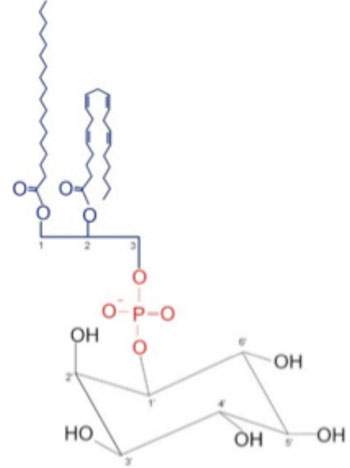Cancer Cells with p53 Mutations Have Phosphatidylinositol Signaling Molecules with Shortened Lipid Acyl Chains
By LabMedica International staff writers
Posted on 14 Jan 2015
A recent study showed that cancer cells with mutations in the p53 gene were distinguished by reduced-length fatty acid moieties in their cell membranes.Posted on 14 Jan 2015
Phosphatidylinositol phosphate (PIP) second messengers relay growth cues via the cell membrane through the phosphorylation status of the inositol sugar, a signal transduction system that is deregulated in cancer. In contrast to PIP inositol head-group phosphorylation, changes in phosphatidylinositol (PI) lipid acyl chains in cancer have remained ill-defined.

Image: Molecular structure of phosphatidylinositol (Photo courtesy of Wikimedia Commons).
Investigators at Cold Spring Harbor Laboratory (NY, USA) applied a mass-spectrometry-based method capable of unbiased high-throughput identification to quantify cellular PI acyl chain composition. Using this approach, they found that PI lipid chains represented a cell-specific fingerprint that was unperturbed by serum-mediated signaling in contrast to the inositol head group. Mutation of p53 resulted in PIs containing fatty acid moieties reduced in length by from two to four carbon atoms.
"What we would like to find out now," said senior author Dr. Lloyd Trotman, an associate professor at Cold Spring Harbor Laboratory, "is whether the p53-induced changes in the PI molecule are important in either making or maintaining the cancer state. If so, then in addition to p53 mutations, there may be other ways for cancer cells to generate the same or related changes. We will be looking for this in tissue samples from cancer patients."
The study was published in the December 24, 2014, online edition of the journal Cell Reports.
Related Links:
Cold Spring Harbor Laboratory













